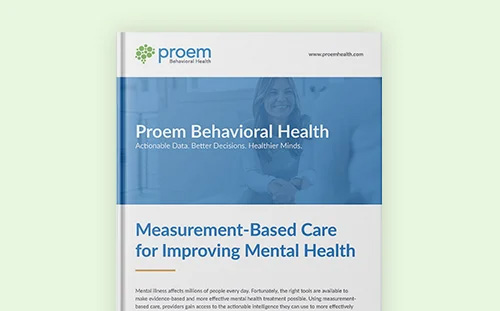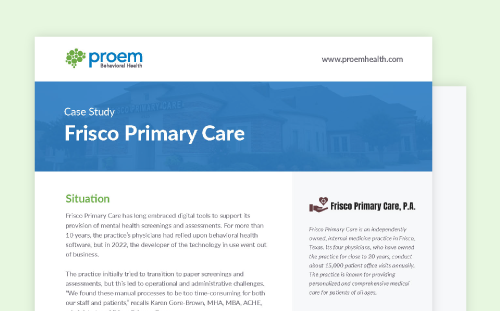A Detailed Guide to the Mini International Neuropsychiatric Interview (M.I.N.I.)
Many screening and assessment tools are available to mental health researchers and clinicians to test for the presence of psychiatric conditions. The Mini International Neuropsychiatric Interview (M.I.N.I.) is one option that’s widely respected in the behavioral health field.
In this resource, you’ll find a detailed look into the M.I.N.I. It will answer a number of common questions about this popular assessment tool, including what it is, when it’s useful, and how to know when it’s the right assessment tool for your research needs.

Chapter 1:
Introduction to the MINI
The Mini International Neuropsychiatric Interview (M.I.N.I.) is a structured psychiatric diagnostic assessment. It’s used to assess the presence of psychiatric disorders as defined in the Diagnostic and Statistical Manual of Mental Disorders (DSM) and the International Classification of Diseases (ICD).
What Is the MINI assessment tool in psychology and psychiatry?
The M.I.N.I. is a mental health assessment tool presented in an interview format. The test subject is asked a series of questions about their mental health, most of which they can respond to with either “yes” or “no.” Their responses help researchers and clinicians determine whether a mental health condition is present
Within the M.I.N.I., assessments for specific disorders are grouped into dedicated sections called modules. Most modules begin with a M.I.N.I. screening tool consisting of a handful of simple questions. If the subject answers “yes” to enough screening questions, it indicates that there is reason to suspect that person may have that condition. They are then asked all other questions in the module to help determine a diagnosis. If the test subject answers “no” to most screening questions, they can skip that module and move on to the next one.
The M.I.N.I. can be conducted on paper, via a digital PDF or online, with the latter two options offering benefits over the paper version (to be discussed further below). The M.I.N.I. is most often administered by a clinician or other trained professional but can also be answered as a patient-led interview. Test subjects are either participants in clinical trials or a patient believed to have one or more mental health conditions.
The M.I.N.I. is widely used by both researchers and clinicians around the world, and it has been translated into more than 70 languages. It takes an average of 15 minutes to complete the M.I.N.I., making the tool one of the quickest options available for assessing mental health. The Mini International Neuropsychiatric Interview’s reliability and validity are both strong.
The M.I.N.I. has been translated into more than
70 languages
What Is the Mini International Neuropsychiatric Interview Used For?
The Mini International Neuropsychiatric Interview questionnaire is used to assess the presence of psychiatric disorders. The M.I.N.I. can be used as a preliminary diagnosis tool by physicians and mental health practitioners, as well as by other professionals in healthcare settings.
In a research setting, the M.I.N.I. is useful for screening potential subjects of clinical trials and for evaluating the presence of a condition after intervention. It’s also useful for epidemiological studies that assess the presence of a condition in a population.
The M.I.N.I.’s flexible, module-based structure means this one interview can be used to diagnose a broad variety of conditions. It’s also able to identify co-occurring conditions, meaning it can be used to diagnose more than one psychiatric disorder in the same patient.
What does the Mini International Neuropsychiatric Interview Measure?
The M.I.N.I. can measure the presence of a variety of different psychiatric disorders as defined in the DSM-V and ICD-11. The M.I.N.I. primarily assesses the presence of Axis I conditions, or clinical disorders, as well as one Axis II condition, or personality disorder.
The standard Mini International Neuropsychiatric Interview for the DSM-V has modules that test for the following:
-
Major depressive disorder
-
Suicidality
-
Bipolar disorders and related disorders
-
Panic disorder
-
Agoraphobia
-
Social anxiety disorder
-
Obsessive-compulsive disorder
-
Post-traumatic stress disorder
-
Alcohol use disorder
-
Substance use disorder (non-alcohol)
-
Psychotic disorders
-
Anorexia nervosa
-
Bulimia nervosa
-
Generalized anxiety disorder
-
Antisocial personality disorder

Chapter 2:
Advantages of the MINI in Research Applications
What Are the Benefits of the Mini International Neuropsychiatric Interview?
The M.I.N.I. offers several advantages not found in other psychiatric interviews and diagnostic tools. It’s known for being quick and easy to use while still providing helpful, accurate information.
Let’s take a closer look at some of its benefits.
Strong Reliability and Validity
The M.I.N.I. has been proven to be both reliable and valid. When tested during its initial development, researchers found that Mini International Neuropsychiatric Interview reliability was excellent on interrater measures and very good on retest measures, according to a paper from The Journal of Clinical Psychiatry detailing its creation.
To prove validity, the inventors of the M.I.N.I. compared its results against the two other common psychiatric diagnostic tests: the Structured Clinical Interview for DSM diagnoses (SCID) and the Composite International Diagnostic Interview for ICD (CIDI). In general, the results showed good or very good concordance between the M.I.N.I. and both the SCID and the CIDI.
Ease of Use
The Mini International Neuropsychiatric Interview questionnaire’s clear wording, easy-to-follow directions for test administrators and short administration time make it accessible for both patients and researchers.
A study published in BMC Family Practice found that the median global satisfaction score with the M.I.N.I. was 80 for patients and 86 for interviewers. Professionals administering the test appreciated that the M.I.N.I. identified comorbidities and helped them obtain accurate diagnoses. Patients stated that the M.I.N.I. helped them verbalize their problems in a way that didn’t feel intrusive.
Recognition of Cooccurring Conditions
It’s very common for psychiatric patients or research subjects to have more than one disorder. As many as 45% have two or more, according to a study from Archives of General Psychiatry. Yet, some psychiatric assessment tools can only diagnose one condition at a time.
The M.I.N.I., with its module-based structure, places no limit on the number of conditions it can diagnose. This gives clinicians and researchers a richer understanding of each patient.
Low Rate of Bias and Mistakes
The M.I.N.I.’s structure makes administrators rely on the instrument instead of their own preconceptions, which can help reduce the rate of incorrect diagnoses. A study published in Innovations in Clinical Neuroscience found that only 11% of psychiatric patients with diagnoses from the M.I.N.I. have their diagnoses changed by discharge, compared to 74% of diagnoses from unstructured clinician interviews.
Additionally, the clear directions for scoring the M.I.N.I. minimize the risk that an administrator will make a mistake and score the test incorrectly. The low likelihood of mistakes is even lower for the digital version of the test, in which scores are calculated automatically.
Availability in Many Languages
The M.I.N.I. has been translated into more than 70 languages. Researchers working with international or multicultural populations can use licensed translations of the M.I.N.I. to conduct their research and feel confident that they are receiving comparable results across different language groups.
These translated versions of the M.I.N.I. have been produced according to high-quality standards. For an example, see this study from Psychiatry and Clinical Neurosciences that found strong reliability and validity for the Japanese version of the M.I.N.I.
Multiple Accessible Versions
As noted, the M.I.N.I. is available in pen-and-paper format, as a PDF or digitally. These different formats allow clinicians and researchers to adapt the format of their interview to one that suits their needs and the patient’s convenience. Clinicians in a one-on-one setting as well as researchers surveying large populations can both benefit from the efficiency of conducting the Mini International Neuropsychiatric Interview electronically.
How long does the Mini International Neuropsychiatric Interview take?
The M.I.N.I. takes approximately 15 minutes to administer.
When initially developed, researchers found that the median duration of the M.I.N.I. was 15 minutes.
The 2018 BMC Family Practice study found that the M.I.N.I. took an average of
26 minutes
to complete.
One of the primary strengths of the M.I.N.I. is its quick administration time, which reduces the burden on patients and administrators alike and helps researchers work more efficiently.

Chapter 3:
What Researchers Should Know About the MINI
The M.I.N.I. offers several benefits to clinicians and researchers alike, but it can be particularly useful in research contexts.
If you’re a clinical researcher or academic researcher considering using the M.I.N.I., the following information can help you determine if it’s the right assessment tool for you.
Why is the MINI good for researchers?
The M.I.N.I. appeals to researchers because of its brevity, ease of administration and widespread applicability.
Since researchers often need to screen large groups of people in a short time, many find it helpful to use a brief, accessible assessment. A test that’s easy to administer also helps keep research workflows efficient.
Researchers also need access to a test that can be applied to a multitude of disorders and given to a broad range of test subjects. The M.I.N.I.’s structure allows it to provide quick diagnoses of several psychiatric conditions, while its clear instructions and available translations allow researchers to administer the tool to diverse populations.
What is the difference between the SCID and the MINI?
Another popular psychiatric diagnostic tool is the Structured Clinical Interview for DSM-V Disorders (SCID).
The SCID is a well-respected, reliable and valid measure that researchers and clinicians alike use to test for many of the same conditions that the M.I.N.I. measures.
Whether a researcher uses the M.I.N.I. or the SCID depends on their unique needs. Let’s look at some of the differences between the M.I.N.I. and the SCID.
SCID

The SCID is semi-structured
The SCID is classified as a “semi-structured interview,” meaning it gives a little more flexibility to administering clinicians in terms of what they say to test subjects. The SCID is still a structured tool that provides diagnoses based on a scoring protocol, but administrators can bring some of their own expertise to how they conduct the interview.
The SCID is more thorough (at a cost)
The added length of the SCID means it can be a little more thorough than the M.I.N.I. The study in Innovations in Clinical Neuroscience found that, among cohorts of subjects at an outpatient psychiatric rehabilitation center, 4% of patients who had received a SCID diagnosis had their diagnosis disconfirmed by discharge. By comparison, 11% of patients with a M.I.N.I. diagnosis had their diagnosis disconfirmed. These numbers suggest the SCID may be slightly more accurate.
However, as noted, the SCID takes significantly longer to administer. As such, the M.I.N.I. is thorough enough for the majority of research situations, and its shorter completion time can greatly aid in expediting the vetting of potential research participants.
MINI

The MINI is structured
By contrast, the M.I.N.I. is highly structured, with specific instructions on the order in which questions should be asked and precise wording for administrators to use. While this reduces flexibility in administration, it also helps ensure uniformity across administrators.
The MINI takes less time to complete
One of the strengths of the M.I.N.I. is that it’s significantly quicker than the SCID. It takes subjects an average of 15 minutes to complete the M.I.N.I. By contrast, the standard research version of the SCID takes 45 to 120 minutes (two hours).
There is a version of the MINI that can be administered to children (MINI-KID)
There is a version of the M.I.N.I., known as the M.I.N.I.-KID, that is modified to fit the needs of children and adolescents. The M.I.N.I.-KID is also available in a Parent version.The M.I.N.I.-KID has been in use for over 25 years. The M.I.N.I.-KID age range is 6-17, so researchers investigating topics related to mental health concerns for children and adolescents in that age range will be best served by the M.I.N.I.-KID. There is no version of the SCID currently available for children and adolescents.
The MINI is available in more languages
Both the M.I.N.I. and the SCID were initially developed in English, but since its development, the M.I.N.I. has been translated into over 70 languages. At the time of this writing, the SCID has only been translated into 14. While the SCID is available in the most widely spoken languages, the M.I.N.I. is likely to be better suited for more diverse populations.
What types of MINI assessments are available?
There are several versions of the Mini International Neuropsychiatric Interview for the DSM-V assessments to choose from, depending on your specific research needs:
1Standard MINI
The test generally referred to when the term “M.I.N.I” as a standalone term is used. This version of the M.I.N.I. contains modules for 17 of the most common mental health conditions and their subtypes.
2 MINI for Psychotic Disorder Studies
A variation of the M.I.N.I. that contains a more detailed set of questions related to psychotic disorders.
3MINI for ADHD Studies
A version of the M.I.N.I. that contains a module assessing the presence of attention-deficit/hyperactive disorders (ADHD).
4MINI for Suicidality Studies
A version of the M.I.N.I. that contains a more detailed set of questions related to suicidality disorders.
5MINI With Borderline Personality Disorder (BPD) Module
A version of the M.I.N.I. that contains a detailed module assessing the presence of borderline personality disorder (BPD).
6MINI Tracking
A version of the M.I.N.I. that converts the binary (yes/no) responses of the standard M.I.N.I. to dimensional response options (none/mild/moderate/very/extreme). This is useful for tracking the progression of a disorder over time.
7MINI Screening Tool
A shortened version of the M.I.N.I. used for preliminary screening instead of diagnosis.
8MINI-KID
A version of the M.I.N.I. specifically designed to be administered to children and adolescents.
What age range is the Mini International Neuropsychiatric Interview used for?
The standard M.I.N.I., and most variations on the standard M.I.N.I., are intended to be used for adult patients and research subjects.
However, as noted, children and adolescents can be tested with a specialized version of the M.I.N.I., known as the MINI-KID assessment tool.
What is the Mini International Neuropsychiatric Interview for Children and Adolescents (M.I.N.I.-KID)?
Let’s take a closer look at the Mini Neuropsychiatric Interview for children and adolescents known as the M.I.N.I.-KID. It is a version of the M.I.N.I. modified to be suitable for subjects under 18. The M.I.N.I.-KID assesses the 24 most common and clinically relevant disorders and disorder subtypes in pediatric mental health. The M.I.N.I.-KID age range is 6-17 years old. The M.I.N.I.-KID is also available as a Parent version, which is helpful when collecting information about younger children.
The wording of the M.I.N.I.-KID assessment tool has been simplified to make it more accessible to children in age groups of 6-8, 9-12 and 13-17. When the M.I.N.I.-KID is administered, parents are usually asked to be present but silent, only speaking up if they feel their child has answered inaccurately.
In most cases, the M.I.N.I.-KID can be successfully administered with a conversation solely between the clinician and the test subject. For cases when it cannot, there is a version of the M.I.N.I.-KID designed for parents.
Like the adult version of the M.I.N.I., the M.I.N.I.-KID is available in a paper version, online or as the M.I.N.I.-KID questionnaire PDF.
Other versions of the M.I.N.I.-KID include:
-
M.I.N.I.-KID/Kid Parent for Psychotic Disorders Studies
-
Adolescent M.I.N.I.-KID for Suicidality Disorders Studies (designed for ages 13-17)
-
M.I.N.I.-KID Tracking
-
M.I.N.I.-KID Screen

Chapter 4:
Administering the MINI in Research Settings
The M.I.N.I. is fairly simple for trained professionals to administer. Here is some basic information about how to use the M.I.N.I. in a research setting.
How is the MINI administered?
The M.I.N.I. is administered by a clinician or other trained professional asking test questions according to the script provided. The administrator then marks whether the interview subject answers “yes” or “no” to each question.
The M.I.N.I. can be administered via pen-and-paper, a PDF or digitally. In all modes, it's recommended that a trained professional be involved with the assessment. However, the digital version makes it possible for interviewees to complete the assessment independently and have it later reviewed by a professional.
Who can administer the Mini International Neuropsychiatric Interview?
Clinicians with experience as either a licensed psychiatrist or clinical psychologist can administer the M.I.N.I. People with less clinical experience can administer the M.I.N.I., but they would first need to receive training.
How to score the Mini International Neuropsychiatric Interview
-
When conducting the M.I.N.I. on paper or PDF, after the administrator finishes a module, they are instructed to count the number of questions to which the subject answered “yes.” The number of “yes” answers determines whether the subject meets criteria for that condition.
-
The exact number of “yes” answers necessary to meet criteria is different for each module. In addition, many modules have additional scoring features to take into account. For example, the module for suicidality has additional instructions for classifying severity as “low,” “medium,” or “high.” Differences between modules account for the nuances of each condition. Each module contains specific instructions that explain all scoring details to administrators.
-
When conducting the M.I.N.I. electronically, scoring is completed automatically in a matter of seconds. That is one key benefit of using the electronic version of the M.I.N.I.

Chapter 5:
Why Use the MINI?
In addition to the specific benefits of the M.I.N.I. already highlighted, it’s worthwhile to take a step back and examine the benefits of its usage for behavioral health research in general and why incorporating an assessment tool like the M.I.N.I. is important.
How the MINI enhances clinical research
Learning more about how our mental health works and how to treat mental health conditions is necessary for promoting a healthy society overall. As the National Council for Mental Wellbeing explains, mental health research is essential for detecting trends in biopsychosocial health, understanding how to promote mental health in different populations and more.
Mental health research can only be trusted when supported by data backed by rigorous standards. While mental health itself is often difficult to quantify, research that isn’t quantified to the best of researchers’ abilities cannot be considered trustworthy enough to inform treatment.
Assessment tools like the M.I.N.I. do the difficult work of attaching hard data to the nebulous field of mental health. They help clarify subjective experiences into data points researchers can then use to inform the development of effective, scientifically proven interventions.
Why use the digital version of the MINI psychiatric interview?
-
While using a paper version of the M.I.N.I. is perfectly acceptable, one of the M.I.N.I.’s many strengths is that it’s also available digitally. This means, in part, that researchers can obtain the Mini Neuropsychiatric Interview PDF and print it out for use instead of having to purchase several paper copies. Similarly, researchers can use the M.I.N.I.-KID questionnaire PDF for easier distribution to pediatric patients.
-
It also means that researchers can give the M.I.N.I. entirely online. Administering the Mini International Neuropsychiatric Interview online broadens researchers’ reach and allows them to assess subjects who may not live physically close to them or who cannot make it to an in-person interview.
-
The digital version of the M.I.N.I. can be completed by subjects on their computer, either on their own or while supervised via videoconference.
-
Allowing research subjects to complete the M.I.N.I. on their own time saves time and effort for researchers and subjects alike, and doing so can improve compliance among subjects. Additionally, some subjects may feel more comfortable and be more truthful when answering questions without supervision.
-
The digital M.I.N.I. also allows for more efficient data collection. Answers are stored digitally, and data is automatically aggregated, which makes for more efficient reporting. Scoring is automatic as well, which speeds up the screening process and lessens the chance of scoring errors.
Get Access to the Licensed Digital Version of the MINI
Proem is the exclusive digital licensee of the M.I.N.I., making them the only provider that can offer the Mini International Neuropsychiatric Interview online. Proem also can provide the M.I.N.I in PDF/paper format.
Proem is no stranger to digital psychiatric assessment, offering dozens of psychiatric assessments online. Its highly efficient tools and proprietary algorithms simplify the process of testing for the presence of psychiatric conditions, so researchers can, in turn, simplify their research workflows.
Use the licensed digital version of the M.I.N.I. to save time, improve efficiency, better collect data and mitigate errors in your research projects. You’ll be able to reach more subjects while also improving the quality of your data and reducing the time it takes to collect the data you need.
Find out more about how Proem’s exclusive digital license of the M.I.N.I. can enhance your research. Get access to the tool and schedule a 1:1 meeting today.





.png)

